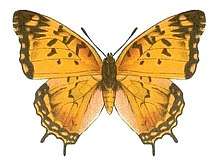Charaxes jahlusa
Charaxes jahlusa, the pearl-spotted emperor or pearl spotted charaxes, is a butterfly of the family Nymphalidae found in southern Africa.[1]
| Pearl-spotted emperor | |
|---|---|
 | |
| From Adalbert Seitz's Fauna Africana | |
| Scientific classification | |
| Kingdom: | Animalia |
| Phylum: | Arthropoda |
| Class: | Insecta |
| Order: | Lepidoptera |
| Family: | Nymphalidae |
| Genus: | Charaxes |
| Species: | C. jahlusa |
| Binomial name | |
| Charaxes jahlusa (Trimen, 1862) | |
| Synonyms | |
| |
The wingspan is 43–56 mm in males and 50–62 mm in females. Flight period is from October to March, some species are year-round.[2]
Larvae feed on Pappea capensis, Dalbergia melanoxylon, and Haplocoelum foliosum.[1][2]
Taxonomy
Charaxes jahlusa is the sole member of the Charaxes jahlusa species group
Subspecies
Listed alphabetically.[1]
- C. j. argynnides Westwood, 1864 — southern Angola, Democratic Republic of the Congo, southern Tanzania, Malawi, Zambia, Mozambique, northern and eastern Zimbabwe, northern Botswana, South Africa: KwaZulu-Natal, Swaziland
- C. j. ganalensis Carpenter, 1937 — southern Sudan, south-western Ethiopia, northern Uganda, western Kenya
- C. j. jahlusa (Trimen, 1862) — South Africa: Eastern Cape Province, Western Cape Province
- C. j. kenyensis Joicey & Talbot, 1925 — eastern and north-eastern Kenya, north-eastern Tanzania
- C. j. kigomaensis van Someren, 1975 — Tanzania: north-west to the eastern shores of Lake Tanganyika
- C. j. mafiae Turlin & Lequeux, 1992 — Tanzania: Mafia Island
- C. j. rex Henning, 1978 — southern Zimbabwe, south-eastern Botswana, South Africa: Limpopo, Mpumalanga, North West and Gauteng provinces
- C. j. rwandensis Plantrou, 1976 — western Rwanda, north-western Tanzania
gollark: There are lots of *imaginable* and *claimed* gods, so I'm saying "gods".
gollark: So basically, the "god must exist because the universe is complex" thing ignores the fact that it... isn't really... and that gods would be pretty complex too, and does not answer any questions usefully because it just pushes off the question of why things exist to why *god* exists.
gollark: To randomly interject very late, I don't agree with your reasoning here. As far as physicists can tell, while pretty complex and hard for humans to understand, relative to some other things the universe runs on simple rules - you can probably describe the way it works in maybe a book's worth of material assuming quite a lot of mathematical background. Which is less than you might need for, say, a particularly complex modern computer system. You know what else is quite complex? Gods. They are generally portrayed as acting fairly similarly to humans (humans like modelling other things as basically-humans and writing human-centric stories), and even apart from that are clearly meant to be intelligent agents of some kind. Both of those are complicated - the human genome is something like 6GB, a good deal of which probably codes for brain things. As for other intelligent things, despite having tons of data once trained, modern machine learning things are admittedly not very complex to *describe*, but nobody knows what an architecture for general intelligence would look like.
gollark: https://media.discordapp.net/attachments/348702212110680064/896356765267025940/FB_IMG_1633757163544.jpg
gollark: https://isotropic.org/papers/chicken.pdf
References
- "Charaxes Ochsenheimer, 1816" at Markku Savela's Lepidoptera and Some Other Life Forms
- Woodhall, Steve (2005). Field Guide to Butterflies of South Africa. Cape Town, South Africa: Struik. ISBN 978-1-86872-724-7.
- Victor Gurney Logan Van Someren, 1974 Revisional notes on African Charaxes (Lepidoptera: Nymphalidae). Part IX. Bulletin of the British Museum of Natural History (Entomology) 29 (8):415-487.
- Seitz, A. Die Gross-Schmetterlinge der Erde 13: Die Afrikanischen Tagfalter. Plate XIII 31
External links
| Wikimedia Commons has media related to Charaxes jahlusa. |
- Images of Charaxes jahlusa argynnides Royal Museum for Central Africa (Albertine Rift Project)
- Images of Charaxes jahlusa ganalensis (Albertine Rift Project)
- Images of C. jahlusa kenyensis (Albertine Rift Project)
- Images of C. jahlusa kigomaensis (Albertine Rift Project)
- Images of C. jahlusa rwandensis (Albertine Rift Project)
- Charaxes jahlusa images at Consortium for the Barcode of Life
- Charaxes jahlusa argynides images at BOLD
- Charaxes jahlusa mafiae images at BOLD
- Charaxes jahlusa pembana images at BOLD
- Charaxes jahlusa rwandensis images at BOLD
This article is issued from Wikipedia. The text is licensed under Creative Commons - Attribution - Sharealike. Additional terms may apply for the media files.